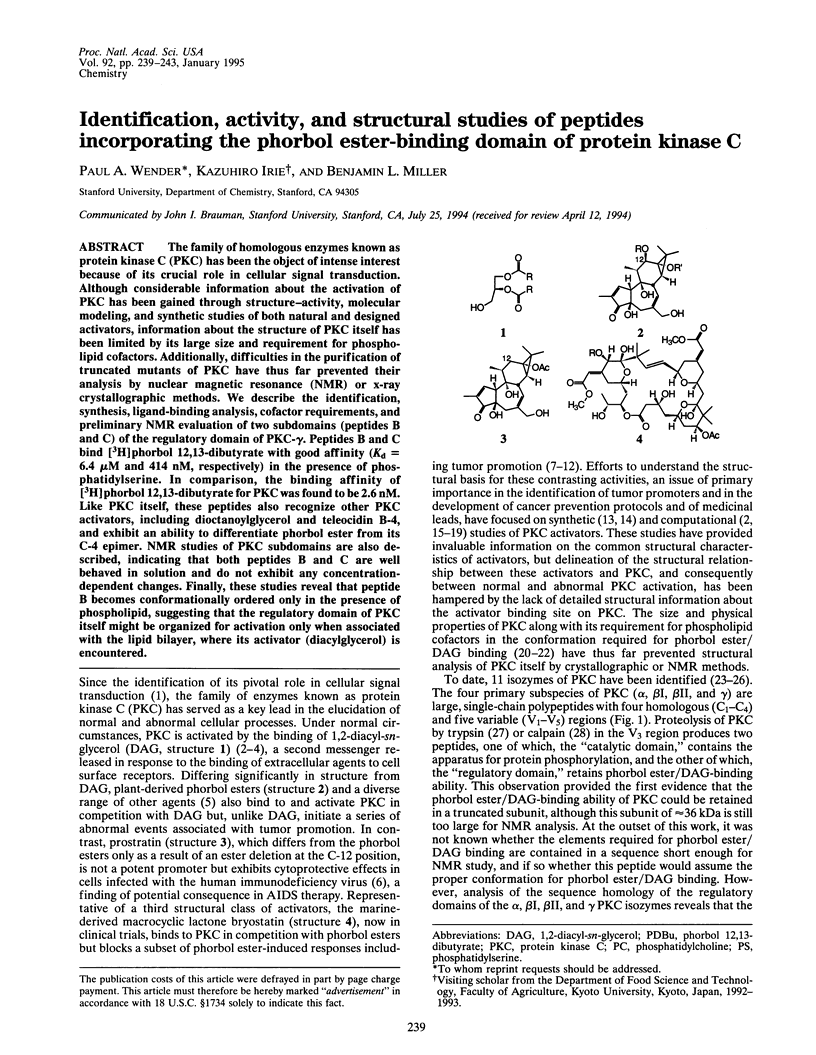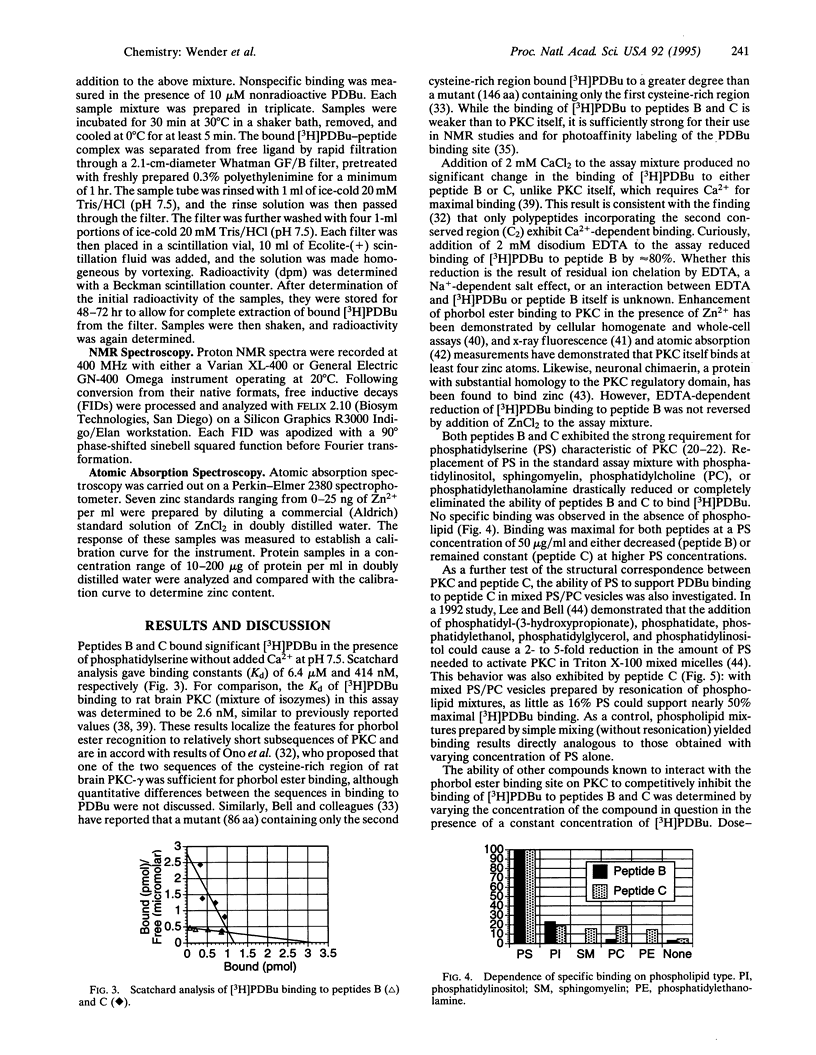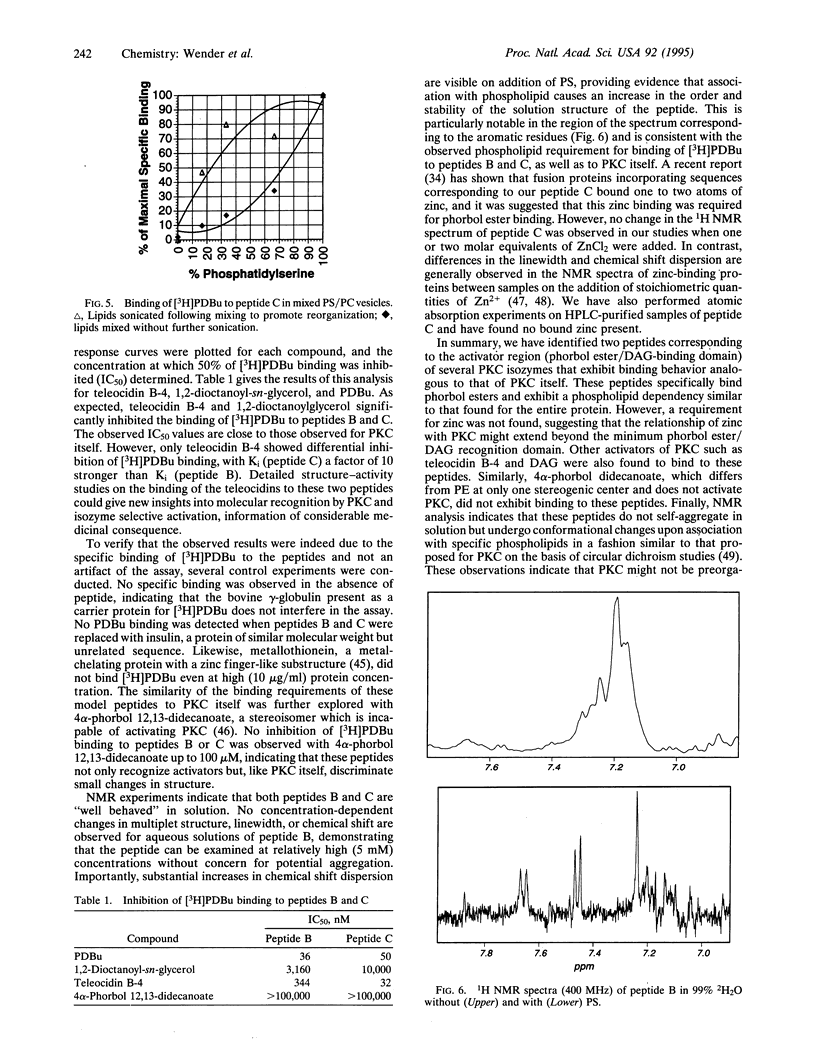Abstract
The family of homologous enzymes known as protein kinase C (PKC) has been the object of intense interest because of its crucial role in cellular signal transduction. Although considerable information about the activation of PKC has been gained through structure-activity, molecular modeling, and synthetic studies of both natural and designed activators, information about the structure of PKC itself has been limited by its large size and requirement for phospholipid cofactors. Additionally, difficulties in the purification of truncated mutants of PKC have thus far prevented their analysis by nuclear magnetic resonance (NMR) or x-ray crystallographic methods. We describe the identification, synthesis, ligand-binding analysis, cofactor requirements, and preliminary NMR evaluation of two subdomains (peptides B and C) of the regulatory domain of PKC-gamma. Peptides B and C bind [3H]phorbol 12,13-dibutyrate with good affinity (Kd = 6.4 microM and 414 nM, respectively) in the presence of phosphatidylserine. In comparison, the binding affinity of [3H]phorbol 12,13-dibutyrate for PKC was found to be 2.6 nM. Like PKC itself, these peptides also recognize other PKC activators, including dioctanoylglycerol and teleocidin B-4, and exhibit an ability to differentiate phorbol ester from its C-4 epimer. NMR studies of PKC subdomains are also described, indicating that both peptides B and C are well behaved in solution and do not exhibit any concentration-dependent changes. Finally, these studies reveal that peptide B becomes conformationally ordered only in the presence of phospholipid, suggesting that the regulatory domain of PKC itself might be organized for activation only when associated with the lipid bilayer, where its activator (diacylglycerol) is encountered.
Full text
PDF




Selected References
These references are in PubMed. This may not be the complete list of references from this article.
- Ahmed S., Kozma R., Lee J., Monfries C., Harden N., Lim L. The cysteine-rich domain of human proteins, neuronal chimaerin, protein kinase C and diacylglycerol kinase binds zinc. Evidence for the involvement of a zinc-dependent structure in phorbol ester binding. Biochem J. 1991 Nov 15;280(Pt 1):233–241. doi: 10.1042/bj2800233. [DOI] [PMC free article] [PubMed] [Google Scholar]
- Azzi A., Boscoboinik D., Hensey C. The protein kinase C family. Eur J Biochem. 1992 Sep 15;208(3):547–557. doi: 10.1111/j.1432-1033.1992.tb17219.x. [DOI] [PubMed] [Google Scholar]
- Bacher N., Zisman Y., Berent E., Livneh E. Isolation and characterization of PKC-L, a new member of the protein kinase C-related gene family specifically expressed in lung, skin, and heart. Mol Cell Biol. 1991 Jan;11(1):126–133. doi: 10.1128/mcb.11.1.126. [DOI] [PMC free article] [PubMed] [Google Scholar]
- Bell R. M. Protein kinase C activation by diacylglycerol second messengers. Cell. 1986 Jun 6;45(5):631–632. doi: 10.1016/0092-8674(86)90774-9. [DOI] [PubMed] [Google Scholar]
- Berkow R. L., Kraft A. S. Bryostatin, a non-phorbol macrocyclic lactone, activates intact human polymorphonuclear leukocytes and binds to the phorbol ester receptor. Biochem Biophys Res Commun. 1985 Sep 30;131(3):1109–1116. doi: 10.1016/0006-291x(85)90205-0. [DOI] [PubMed] [Google Scholar]
- Burns D. J., Bell R. M. Protein kinase C contains two phorbol ester binding domains. J Biol Chem. 1991 Sep 25;266(27):18330–18338. [PubMed] [Google Scholar]
- Burns D. J., Bloomenthal J., Lee M. H., Bell R. M. Expression of the alpha, beta II, and gamma protein kinase C isozymes in the baculovirus-insect cell expression system. Purification and characterization of the individual isoforms. J Biol Chem. 1990 Jul 15;265(20):12044–12051. [PubMed] [Google Scholar]
- Castagna M., Takai Y., Kaibuchi K., Sano K., Kikkawa U., Nishizuka Y. Direct activation of calcium-activated, phospholipid-dependent protein kinase by tumor-promoting phorbol esters. J Biol Chem. 1982 Jul 10;257(13):7847–7851. [PubMed] [Google Scholar]
- Farago A., Nishizuka Y. Protein kinase C in transmembrane signalling. FEBS Lett. 1990 Aug 1;268(2):350–354. doi: 10.1016/0014-5793(90)81284-u. [DOI] [PubMed] [Google Scholar]
- Forbes I. J., Zalewski P. D., Giannakis C., Petkoff H. S., Cowled P. A. Interaction between protein kinase C and regulatory ligand is enhanced by a chelatable pool of cellular zinc. Biochim Biophys Acta. 1990 Jul 12;1053(2-3):113–117. doi: 10.1016/0167-4889(90)90001-t. [DOI] [PubMed] [Google Scholar]
- Gustafson K. R., Cardellina J. H., 2nd, McMahon J. B., Gulakowski R. J., Ishitoya J., Szallasi Z., Lewin N. E., Blumberg P. M., Weislow O. S., Beutler J. A. A nonpromoting phorbol from the samoan medicinal plant Homalanthus nutans inhibits cell killing by HIV-1. J Med Chem. 1992 May 29;35(11):1978–1986. doi: 10.1021/jm00089a006. [DOI] [PubMed] [Google Scholar]
- House C., Kemp B. E. Protein kinase C pseudosubstrate prototope: structure-function relationships. Cell Signal. 1990;2(2):187–190. doi: 10.1016/0898-6568(90)90022-3. [DOI] [PubMed] [Google Scholar]
- Hubbard S. R., Bishop W. R., Kirschmeier P., George S. J., Cramer S. P., Hendrickson W. A. Identification and characterization of zinc binding sites in protein kinase C. Science. 1991 Dec 20;254(5039):1776–1779. doi: 10.1126/science.1763327. [DOI] [PubMed] [Google Scholar]
- Itai A., Kato Y., Tomioka N., Iitaka Y., Endo Y., Hasegawa M., Shudo K., Fujiki H., Sakai S. A receptor model for tumor promoters: rational superposition of teleocidins and phorbol esters. Proc Natl Acad Sci U S A. 1988 Jun;85(11):3688–3692. doi: 10.1073/pnas.85.11.3688. [DOI] [PMC free article] [PubMed] [Google Scholar]
- Jeffrey A. M., Liskamp R. M. Computer-assisted molecular modeling of tumor promoters: rationale for the activity of phorbol esters, teleocidin B, and aplysiatoxin. Proc Natl Acad Sci U S A. 1986 Jan;83(2):241–245. doi: 10.1073/pnas.83.2.241. [DOI] [PMC free article] [PubMed] [Google Scholar]
- Kishimoto A., Kajikawa N., Shiota M., Nishizuka Y. Proteolytic activation of calcium-activated, phospholipid-dependent protein kinase by calcium-dependent neutral protease. J Biol Chem. 1983 Jan 25;258(2):1156–1164. [PubMed] [Google Scholar]
- Leach K. L., James M. L., Blumberg P. M. Characterization of a specific phorbol ester aporeceptor in mouse brain cytosol. Proc Natl Acad Sci U S A. 1983 Jul;80(14):4208–4212. doi: 10.1073/pnas.80.14.4208. [DOI] [PMC free article] [PubMed] [Google Scholar]
- Lee M. H., Bell R. M. Phospholipid functional groups involved in protein kinase C activation, phorbol ester binding, and binding to mixed micelles. J Biol Chem. 1989 Sep 5;264(25):14797–14805. [PubMed] [Google Scholar]
- Lee M. H., Bell R. M. Supplementation of the phosphatidyl-L-serine requirement of protein kinase C with nonactivating phospholipids. Biochemistry. 1992 Jun 9;31(22):5176–5182. doi: 10.1021/bi00137a013. [DOI] [PubMed] [Google Scholar]
- Mosior M., Epand R. M. Mechanism of activation of protein kinase C: roles of diolein and phosphatidylserine. Biochemistry. 1993 Jan 12;32(1):66–75. doi: 10.1021/bi00052a010. [DOI] [PubMed] [Google Scholar]
- Nishizuka Y. The molecular heterogeneity of protein kinase C and its implications for cellular regulation. Nature. 1988 Aug 25;334(6184):661–665. doi: 10.1038/334661a0. [DOI] [PubMed] [Google Scholar]
- Nishizuka Y. The role of protein kinase C in cell surface signal transduction and tumour promotion. Nature. 1984 Apr 19;308(5961):693–698. doi: 10.1038/308693a0. [DOI] [PubMed] [Google Scholar]
- Nordberg G. F., Nordberg M., Piscator M., Vesterberg O. Separation of two forms of rabbit metallothionein by isoelectric focusing. Biochem J. 1972 Feb;126(3):491–498. doi: 10.1042/bj1260491. [DOI] [PMC free article] [PubMed] [Google Scholar]
- Ono Y., Fujii T., Igarashi K., Kuno T., Tanaka C., Kikkawa U., Nishizuka Y. Phorbol ester binding to protein kinase C requires a cysteine-rich zinc-finger-like sequence. Proc Natl Acad Sci U S A. 1989 Jul;86(13):4868–4871. doi: 10.1073/pnas.86.13.4868. [DOI] [PMC free article] [PubMed] [Google Scholar]
- Ono Y., Fujii T., Ogita K., Kikkawa U., Igarashi K., Nishizuka Y. The structure, expression, and properties of additional members of the protein kinase C family. J Biol Chem. 1988 May 15;263(14):6927–6932. [PubMed] [Google Scholar]
- Osada S., Mizuno K., Saido T. C., Akita Y., Suzuki K., Kuroki T., Ohno S. A phorbol ester receptor/protein kinase, nPKC eta, a new member of the protein kinase C family predominantly expressed in lung and skin. J Biol Chem. 1990 Dec 25;265(36):22434–22440. [PubMed] [Google Scholar]
- Pan T., Giedroc D. P., Coleman J. E. 1H NMR studies of T4 gene 32 protein: effects of zinc removal and reconstitution. Biochemistry. 1989 Oct 31;28(22):8828–8832. doi: 10.1021/bi00448a022. [DOI] [PubMed] [Google Scholar]
- Philip P. A., Rea D., Thavasu P., Carmichael J., Stuart N. S., Rockett H., Talbot D. C., Ganesan T., Pettit G. R., Balkwill F. Phase I study of bryostatin 1: assessment of interleukin 6 and tumor necrosis factor alpha induction in vivo. The Cancer Research Campaign Phase I Committee. J Natl Cancer Inst. 1993 Nov 17;85(22):1812–1818. doi: 10.1093/jnci/85.22.1812. [DOI] [PubMed] [Google Scholar]
- Prendiville J., Crowther D., Thatcher N., Woll P. J., Fox B. W., McGown A., Testa N., Stern P., McDermott R., Potter M. A phase I study of intravenous bryostatin 1 in patients with advanced cancer. Br J Cancer. 1993 Aug;68(2):418–424. doi: 10.1038/bjc.1993.352. [DOI] [PMC free article] [PubMed] [Google Scholar]
- Quest A. F., Bardes E. S., Bell R. M. A phorbol ester binding domain of protein kinase C gamma. Deletion analysis of the Cys2 domain defines a minimal 43-amino acid peptide. J Biol Chem. 1994 Jan 28;269(4):2961–2970. [PubMed] [Google Scholar]
- Quest A. F., Bloomenthal J., Bardes E. S., Bell R. M. The regulatory domain of protein kinase C coordinates four atoms of zinc. J Biol Chem. 1992 May 15;267(14):10193–10197. [PubMed] [Google Scholar]
- Rando R. R., Kishi Y. Structural basis of protein kinase C activation by diacylglycerols and tumor promoters. Biochemistry. 1992 Mar 3;31(8):2211–2218. doi: 10.1021/bi00123a001. [DOI] [PubMed] [Google Scholar]
- Sako T., Yuspa S. H., Herald C. L., Pettit G. R., Blumberg P. M. Partial parallelism and partial blockade by bryostatin 1 of effects of phorbol ester tumor promoters on primary mouse epidermal cells. Cancer Res. 1987 Oct 15;47(20):5445–5450. [PubMed] [Google Scholar]
- Shah J., Shipley G. G. Circular dichroic studies of protein kinase C and its interactions with calcium and lipid vesicles. Biochim Biophys Acta. 1992 Feb 13;1119(1):19–26. doi: 10.1016/0167-4838(92)90228-6. [DOI] [PubMed] [Google Scholar]
- Smith J. B., Smith L., Pettit G. R. Bryostatins: potent, new mitogens that mimic phorbol ester tumor promoters. Biochem Biophys Res Commun. 1985 Nov 15;132(3):939–945. doi: 10.1016/0006-291x(85)91898-4. [DOI] [PubMed] [Google Scholar]
- Stabel S., Parker P. J. Protein kinase C. Pharmacol Ther. 1991;51(1):71–95. doi: 10.1016/0163-7258(91)90042-k. [DOI] [PubMed] [Google Scholar]
- Tanaka Y., Miyake R., Kikkawa U., Nishizuka Y. Rapid assay of binding of tumor-promoting phorbol esters to protein kinase C1. J Biochem. 1986 Jan;99(1):257–261. doi: 10.1093/oxfordjournals.jbchem.a135467. [DOI] [PubMed] [Google Scholar]
- Wender P. A., Cribbs C. M., Koehler K. F., Sharkey N. A., Herald C. L., Kamano Y., Pettit G. R., Blumberg P. M. Modeling of the bryostatins to the phorbol ester pharmacophore on protein kinase C. Proc Natl Acad Sci U S A. 1988 Oct;85(19):7197–7201. doi: 10.1073/pnas.85.19.7197. [DOI] [PMC free article] [PubMed] [Google Scholar]
- Wender P. A., Koehler K. F., Sharkey N. A., Dell'Aquila M. L., Blumberg P. M. Analysis of the phorbol ester pharmacophore on protein kinase C as a guide to the rational design of new classes of analogs. Proc Natl Acad Sci U S A. 1986 Jun;83(12):4214–4218. doi: 10.1073/pnas.83.12.4214. [DOI] [PMC free article] [PubMed] [Google Scholar]
- Young S., Rothbard J., Parker P. J. A monoclonal antibody recognising the site of limited proteolysis of protein kinase C. Inhibition of down-regulation in vivo. Eur J Biochem. 1988 Apr 5;173(1):247–252. doi: 10.1111/j.1432-1033.1988.tb13991.x. [DOI] [PubMed] [Google Scholar]
- de Vries D. J., Herald C. L., Pettit G. R., Blumberg P. M. Demonstration of sub-nanomolar affinity of bryostatin 1 for the phorbol ester receptor in rat brain. Biochem Pharmacol. 1988 Nov 1;37(21):4069–4073. doi: 10.1016/0006-2952(88)90097-4. [DOI] [PubMed] [Google Scholar]


